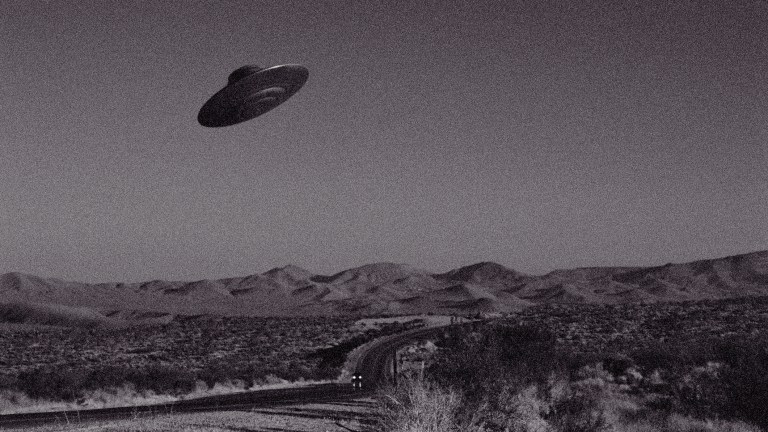Why 2023 Is “The Year of Science” in UFOs
UFO researcher Ryan Sprague points to wealth of scientific studies into unidentified anomalous phenomena.

Since The New York Times published the bombshell article in 2017 about the Department of Defense program investigating Unidentified Anomalous Phenomena — the government term for Unidentified Flying Objects — the topic of what’s “out there” has returned to the mainstream in a manner perhaps eclipsing even the UFO craze that began in the late 1940s. And each subsequent year brings even more news coverage, speculation, and government responses — or, more frequently, vague non-answers.
But 2023 looks to be “the year of science” in UAP research, according to Ryan Sprague, Ancient Aliens pundit and host of Somewhere in the Skies, a weekly podcast covering UFOs and the unexplained.
Joining the Talking Strange paranormal pop culture show for a recent episode (available on Apple Podcasts, Spotify, and YouTube), Sprague says there are numerous scientifically minded and academic “civilian-funded, passionate people outside of government trying to find answers.”
Sprague’s comments come on the heels of a fairly significant year in UAP news. Last May, Congress held the first open hearing on the topic in more than 50 years, although the main headline coming out of that was what was not said, as opposed to what was revealed. Then, in July, the DoD announced the establishment of the All-domain Anomaly Resolution Office (AARO) with the intent to synchronize efforts across government agencies to “detect, identify and attribute objects of interest” including “anomalous, unidentified space, airborne, submerged and transmedium objects.” In December 2022, a bipartisan amendment to the National Defense Authorization Act required the Defense Department to review documents about UAPs dating back to 1945, which might be a game changer in the study of the phenomenon. Additionally, in October NASA kicked off an independent nine-month study to examine unclassified data from both government and civilian sources to determine “how best to collect future data, and how NASA can use that data to move the scientific understanding of UAPs forward.”
“You finally have NASA getting involved in the UFO game,” jokes Sprague. “I feel like they had FOMO when all this was going on, and they were like, ‘Hey, we’re NASA! We absolutely should be part of this.’”
Sprague says the NASA report, due some time in Spring 2023 — and led by a team of 16, including astrophysicists, a journalist, astronaut, oceanographer, and others— is important because its focus is not just on military cases, and they’ll be retroactively looking at files and examining space anomalies through a scientific lens.
“You’ve got every kind of scientist you can think of coming in from all different angles trying to attack this mystery. We’re finally seeing this convergence of civilian and government, and I can’t wait to see what comes of it.”
Another group Sprague is excited about is American Institute of Aeronautics and Astronautics, and its newly-formed Unidentified Anomalous Phenomena Integration & Outreach Committee. The AIAA is the world’s largest aerospace technical society, and the committee’s mission is “to improve aerospace safety by enhancing scientific knowledge of, and mitigating barriers to the study of, Unidentified Anomalous Phenomena.” The committee’s chair is Lt. Ryan Graves, the former Navy fighter pilot who became famous in 2019 for disclosing he had regularly seen UAPs over the course of numerous years while serving.
“This is now a committee where civilian pilots can go to to report their UFO sightings, which we never had before,” says Sprague. “I hope it inspires more pilots to come forward.”
Also exciting Sprague this year is the work of Harvard University astrophysicist Avi Loeb who previously was chair of the university’s astronomy department and currently leads the Galileo Project for the Systematic Scientific Search for Evidence of Extraterrestrial Technological Artifacts. Loeb’s project launched in 2021, but ramped up with data collection at the end of last year, with the goal to “bring the search for extraterrestrial technological signatures of Extraterrestrial Technological Civilizations (ETCs) from accidental or anecdotal observations and legends to the mainstream of transparent, validated and systematic scientific research.”
“It’s kind of a spin-off of SETI,” says Sprague, referencing the Search for Extraterrestrial Life experiment. “While SETI looks for radio waves, or signatures like that in space, of possible aliens or something out there, Avi Loeb is hellbent on finding these things called technosignatures: actual things, artifacts, on planets, on moons, that could be considered technologically advanced.”
That might include pollution, energy signatures, and physical structures indicative of ETCs.
Other groups Sprague says to watch this year is UAPx, the non-profit scientific research organization studying the topic, and Scientific Coalition for UAP Studies (SCU) a self-described “think tank of scientists, researchers and professionals stretching across organizations, governments and industries to scientifically and publicly explore anomalous phenomena.”
Taken all together, Sprague says he is optimistic about the year ahead in UAP research, and the scientific findings of the topic.
“The year of science is what I think we’re looking at with UFOs,” he says, before adding, “And maybe some answers.”
For more from this converation, and to check out other paranormal personalities, celebrities, and authors talking about the the unexplained and high strangeness, subscribe to Talking Strange on Spotify, Apple Podcasts, and YouTube, hosted by Aaron Sagers of Netflix’s 28 Days Haunted and discovery+/Travel Channel’s Paranormal Caught on Camera.
